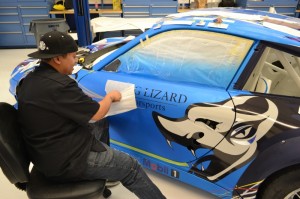Understanding Vehicle Wrap Vinyl Materials
Posted in: Industry News
Custom car wraps and vehicle graphics can come in just about any on all sorts of shapes, colors and images – the options are virtually endless. With a wide variety of materials, colors and textures available, almost anything that can be conceived can be produced and installed.![]()
Vinyl vehicle wrap materials come in many different grades, types, colors, textures and finishes. At Iconography, we believe that happy customers are well-informed customers. With that in mind, we put together this quick overview of vehicle wrap vinyl materials, with some important questions that anyone investing in vehicle graphics should ask a prospective vehicle wrap company.
Vehicle graphics are created from high-grade, pressure-sensitive, adhesive-backed vinyl material. This is a fancy way to say they are big decals or stickers. This material comes in large rolls that can be as long as 150 yards, and in different widths from 15″ to 60″. The material is run through either a plotter to cut it to shape, or a digital printer, depending on the specifics of the project. Here are some basics about the different types of materials that can be used in the vehicle wrap process:
1. High-grade – this means the material is sturdy and durable. High-grade typically refers to “cast” vinyl. Most vinyl manufacturers, including 3M, Avery and Oracal, make the vehicle vinyl materials in several types, depending on long long the material needs to last. Most vehicle wrap vinyls will last anywhere from a few months, to a few years, so when a company tells you they are using 3M vinyl on your vehicle wrap, make sure you ask “which one?” There are basically two grades of vinyls: “calendared” and “cast.” Cast vinyl is higher-grade, and will last longer. We recommend cast vinyl for all of our vehicle wraps. Calendared vinyl should only be used for indoor or very short-term applications.
2. Pressure-sensitive, adhesive-backed – this means the vinyl is coated with a special glue on the back. This glue is in the form of microscopic bubbles that do not display their true adhesive properties until they are activated. Proper activation of the glue happens when a knowledgeable installer systematically uses a combination of a heat gun, blow torch, and squeegee to apply the material. If this process is not done correctly, the glue will not be activated properly, and the wrap will begin to lift or bubble over time. We strongly suggest working with a certified vehicle wrap installation company. Ask if the people installing your vehicle are certified. If so, where did they get their certification. 3M, PDAA, and Oracal all offer certifications through an intensive training program.
Vehicle grade vinyls can also be purchased in a variety of pre-fabricated colors. Each vinyl manufacturer offers a slightly different spectrum of colored vinyls, including matte finishes, metallic vinyls, and textured vinyls. These vinyls can be cut into solid color shapes and sizes, such as lettering, numbering and logos. A couple of benefits of pre-fabricated colored vinyls is that they are consistently the same color, roll to roll, year to year. Also, the highest-grade, cast colored vinyls are the longest lasting vinyls available. These vinyls are a great choice when consistency of color and longevity is of utmost importance to your project. Many fleet graphics use colored vinyl applications. The limitation is that this vinyl can only be used for solid color applications – any graphics with gradients or shades must be printed.
Print medial vinyl is very similar to colored vinyl, except that is comes in large rolls of white only, and is run though a large format digital printer to create whatever custom color is desired. The great benefit of digital print vinyl media is that there is almost no limitation to the graphic output. Pictures, gradients, shades – almost any custom graphic can be achieved. The trade-off is in longevity and in consistency of color. The highest grade print media vinyl will last several years, but will not last as long as some colored vinyls (which we have seen last for decades). Also, the print media is just one component of the final product – inks and laminates are also variables in this equation. So, even though a very high-end printer may use the same media and print at the same settings, slight changes in temperature and humidity from day to day can affect the color output.
Still have questions about vehicle vinyls and media used in creating vehicle wraps? Our experts would be happy to answer any questions you may have. Give us a call at 714-527-5424.
Return to: Understanding Vehicle Wrap Vinyl Materials

Social Web